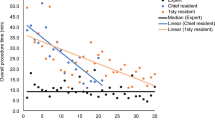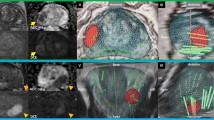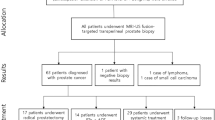Abstract
The objective of this study is to evaluate the performance of urology residents at each training level in detecting prostate cancer with transrectal ultrasound-guided (TRUS) biopsy. The inclusion criteria were: (1) prostate-specific antigen (PSA) 4–10 ng/ml; and (2) 10–12 cores per biopsy session. Data from repeat biopsy sessions were excluded. Overall prostate cancer detection rate for 170 patients was 39.4%. PSA, digital rectal examination (DRE), and prostate volume were predictors of cancer detection. There were no significant differences in overall cancer detection rates, PSA, DRE, or prostate volume between resident levels. In conclusion, urology residents at all levels of training perform equally well at detecting cancer using TRUS prostate biopsy technology.
This is a preview of subscription content, access via your institution
Access options
Subscribe to this journal
Receive 4 print issues and online access
$259.00 per year
only $64.75 per issue
Buy this article
- Purchase on Springer Link
- Instant access to full article PDF
Prices may be subject to local taxes which are calculated during checkout

Similar content being viewed by others
References
American Cancer Society. Cancer Facts and Figures 2003 (http://www.cancer.org).
Hodge KK, McNeal JE, Stamey TA . Ultrasound guided transrectal core biopsies of the palpably abnormal prostate. J Urol 1989; 142: 66–70.
Gerstenbluth RE et al. Does level of expertise influence the cancer detection rate of prostate biopsy? J Urol 2002; 167: 1323 (abstract).
Ellis WJ, Chetner MP, Preston SD, Brawer MK . Diagnosis of prostatic carcinoma: the yield of serum prostate specific antigen, digital rectal examination and transrectal ultrasonography. J Urol 1994; 152: 1520–1525.
Gerstenbluth RE et al. The accuracy of the increased prostate specific antigen level (greater than or equal to 20 ng/ml) in predicting prostate cancer: is biopsy always required? J Urol 2002; 168: 1990–1993.
Letran JL, Meyer GE, Loberiza FR, Brawer MK . The effect of prostate volume on the yield of needle biopsy. J Urol 1998; 160: 1718–1721.
Uzzo RG et al. The influence of prostate size on cancer detection. Urology 1995; 46: 831–836.
Karakiewicz PI et al. Outcome of sextant biopsy according to gland volume. Urology 1997; 49: 55–59.
Basillote JB, Armenakas NA, Hochberg DA, Fracchia JA . Influence of prostate volume in the detection of prostate cancer. Urology 2003; 61: 167–171.
Roobol MJ, Kranse R, van der Cruijsen IW, Schroder FH . A more advanced clinical stage is positively correlated with an increased prostate cancer detection rate. Urology 2002; 59: 91–96.
Taylor III JA, Gancarczyk KJ, Fant GV, Mcleod DG . Increasing the number of core samples taken at prostate needle biopsy enhances the detection of clinically significant prostate cancer. Urology 2002; 60: 841–845.
Babaian RJ et al. A comparative analysis of sextant and an extended 11-core multisite directed biopsy strategy. J Urol 2000; 163: 152–157.
Stewart CS, Leibovich BC, Weaver AL, Lieber MM . Prostate cancer diagnosis using a saturation needle biopsy technique after previous negative sextant biopsies. J Urol 2001; 166: 86–91.
O'Dowd GJ, Miller MC, Orozco R, Veltri RW . Analysis of repeated biopsy results within 1 year after a noncancer diagnosis. Urology 2000; 55: 553–559.
Mian BM et al. Predictors of cancer in repeat extended multisite prostate biopsy in men with previous negative extended multisite biopsy. Urology 2002; 60: 836–840.
Porter CR et al. Predicting the outcome of prostate biopsy in a racially diverse population: a prospective study. Urology 2002; 60: 831–835.
Orozco R et al. Observations on pathology trends in 62,537 prostate biopsies obtained from urology private practices in the United States. Urology 1998; 51: 186–195.
Roehl KA, Antenor JA, Catalona WJ . Serial biopsy results in prostate cancer screening study. J Urol 2002; 167: 2435–2439.
Wise AM, Stamey TA, McNeal JE, Clayton JL . Morphologic and clinical significance of multifocal prostate cancers in radical prostatectomy specimens. Urology 2002; 60: 264–269.
Flanigan RC et al. Accuracy of digital rectal examination and transrectal ultrasonography in localizing prostate cancer. J Urol 1994; 152: 1506–1509.
Author information
Authors and Affiliations
Corresponding author
Additional information
Source of funding: none.
Rights and permissions
About this article
Cite this article
Karam, J., Shulman, M. & Benaim, E. Impact of training level of urology residents on the detection of prostate cancer on TRUS biopsy. Prostate Cancer Prostatic Dis 7, 38–40 (2004). https://doi.org/10.1038/sj.pcan.4500695
Received:
Revised:
Accepted:
Published:
Issue Date:
DOI: https://doi.org/10.1038/sj.pcan.4500695
Keywords
This article is cited by
-
The urologist’s learning curve of “in-bore” magnetic resonance-guided prostate biopsy
BMC Urology (2021)
-
Gleason grade accuracy of transperineal and transrectal prostate biopsies in MRI-naïve patients
International Urology and Nephrology (2021)
-
Association of training level and outcome of software-based image fusion-guided targeted prostate biopsies
World Journal of Urology (2019)



